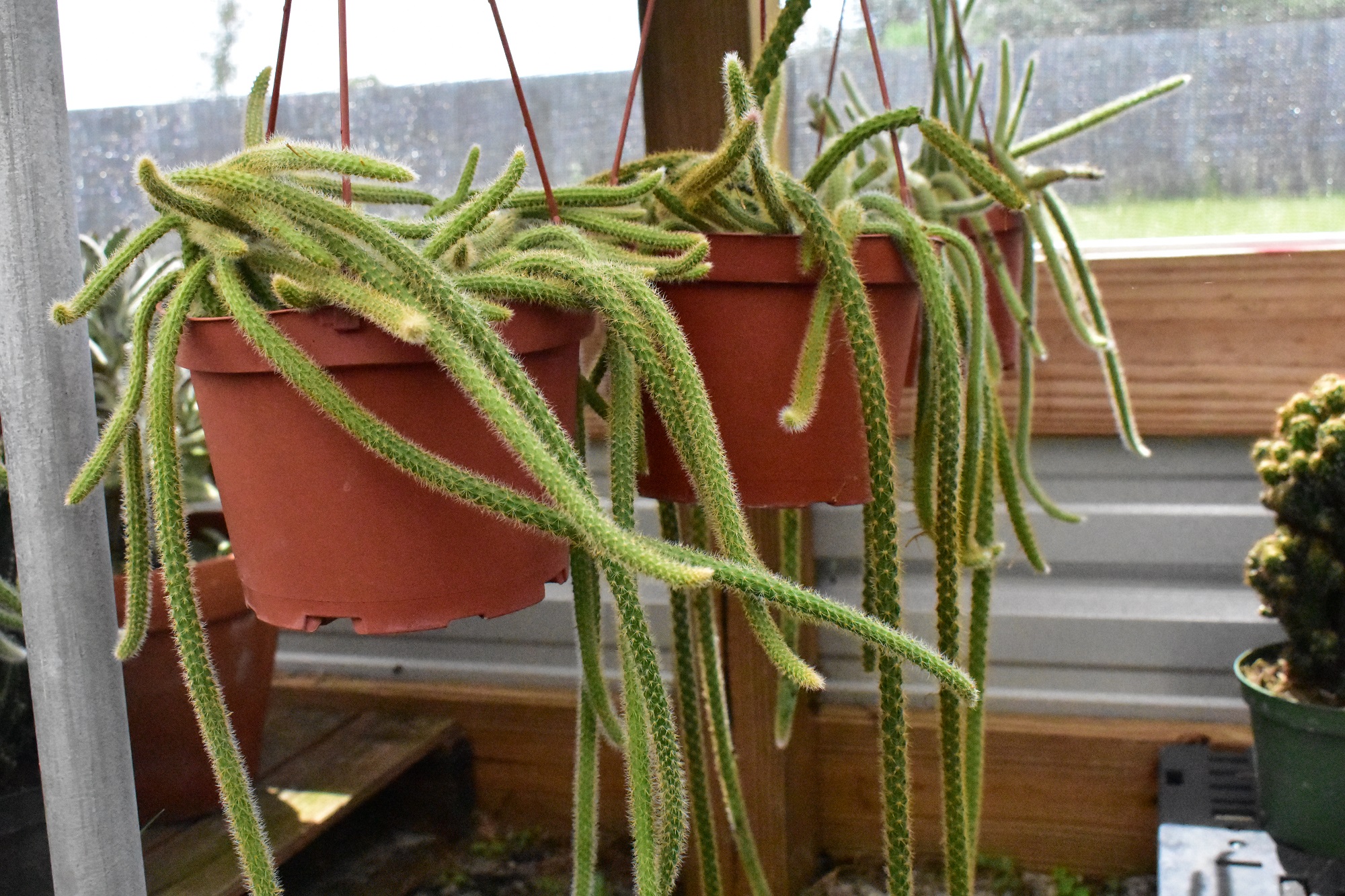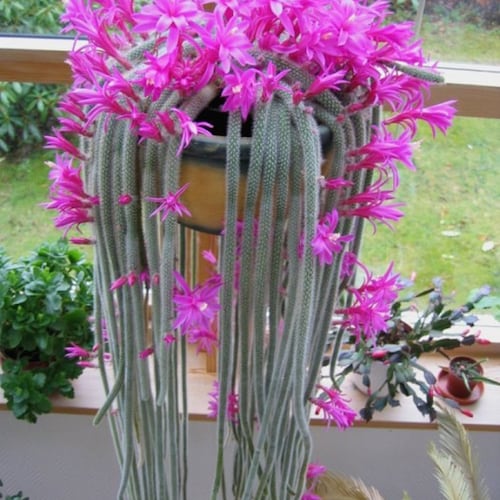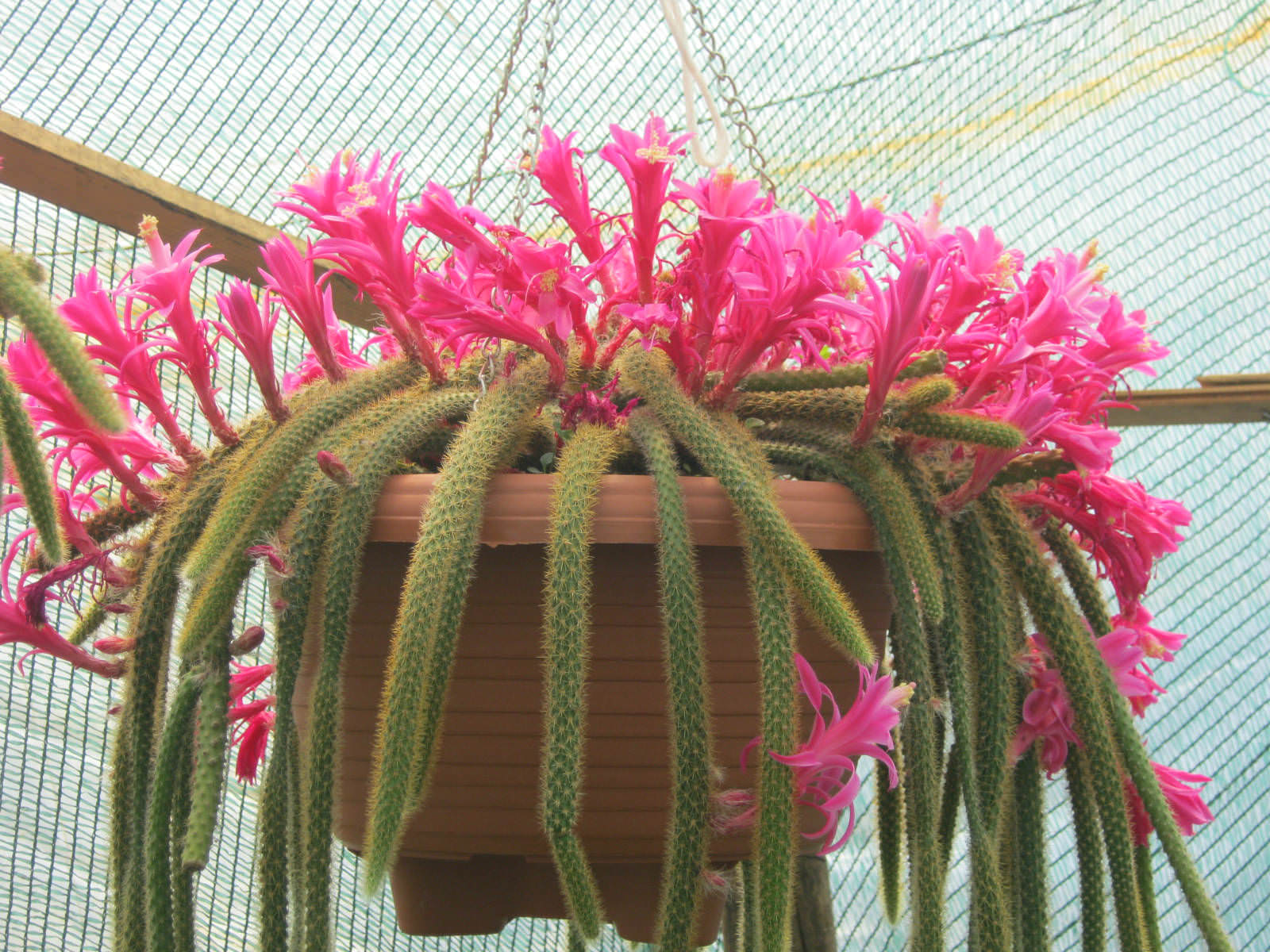This cactus, which has long stems that tend to hang out of its pot or trail along the ground, is very popular and widely grown. Its stems are thick and can grow to a great height before being weighed down and bending. It usually bears purple-red flowers, though sometimes pink or orange blooms have been seen.
Table of Contents
Care and Propagation Information
Aporocactus flagelliformis is widely recognized, and it is closely related to Disocactus phyllanthoides, commonly known as the “German Empress.”
It is best to keep the Rat-Tail Cactus in an environment with consistent temperatures and high humidity, as drastic temperature fluctuations can be damaging to the plant.
Watering
The Disocactus flagelliformis “Rat-Tail Cactus” needs to be watered as most other succulents, but should be given extra attention during the Fall and Spring when it is actively growing. In the Winter, reduce the amount of water and use the “soak and dry” method, making sure the soil is completely dry between waterings.
Where to Plant
The Rat-Tail Cactus, Disocactus flagelliformis, is not tolerant of temperatures lower than 30°F (-1.1°C), so it would be best to grow it in a pot that can be moved inside when cold weather arrives. This species thrives in a spot that receives either full or partial sunlight.
How to Propagate Disocactus flagelliformis “Rat-Tail Cactus”
Disocactus flagelliformis, or “Rat-Tail Cactus”, can be propagated in a few different ways. Fallen stems from the main plant will often root themselves, but you can also pick them up and place them in soil that has good drainage. Additionally, you can propagate the cactus from seed.
Cuttings
To propagate Rat-Tail Cactus, take a cutting with a sterile, sharp knife or scissors and let the cut end heal for several days. Place the cutting on well-draining soil and water only when the soil has completely dried out.
Gain information on how to safely propagate cacti here.
Seeds
To cultivate Disocactus flagelliformis “Rat-Tail Cactus” from seed, plant your seeds in a soil that offers good drainage. If you live in a region with a climate of 10a or higher, you can sow outdoors. For those in cooler areas, it’s best to start indoors with a grow light or heating mat.
Care and Propagation Information
General Care for Disocactus flagelliformis “Rat-Tail Cactus”
It is best to keep the Rat-Tail Cactus in an environment with consistent temperatures and high humidity, as drastic temperature fluctuations can be damaging to the plant.
Watering
The Disocactus flagelliformis “Rat-Tail Cactus” needs to be watered as most other succulents, but should be given extra attention during the Fall and Spring when it is actively growing. In the Winter, reduce the amount of water and use the “soak and dry” method, making sure the soil is completely dry between waterings.
Where to Plant
The Rat-Tail Cactus, Disocactus flagelliformis, is not tolerant of temperatures lower than 30°F (-1.1°C), so it would be best to grow it in a pot that can be moved inside when cold weather arrives. This species thrives in a spot that receives either full or partial sunlight.
How to Propagate Disocactus flagelliformis “Rat-Tail Cactus”
Disocactus flagelliformis, or “Rat-Tail Cactus”, can be propagated in a few different ways. Fallen stems from the main plant will often root themselves, but you can also pick them up and place them in soil that has good drainage. Additionally, you can propagate the cactus from seed.
Cuttings
To propagate Rat-Tail Cactus, take a cutting with a sterile, sharp knife or scissors and let the cut end heal for several days. Place the cutting on well-draining soil and water only when the soil has completely dried out.
Gain information on how to safely propagate cacti here.
Seeds
To cultivate Disocactus flagelliformis “Rat-Tail Cactus” from seed, plant your seeds in a soil that offers good drainage. If you live in a region with a climate of 10a or higher, you can sow outdoors. For those in cooler areas, it’s best to start indoors with a grow light or heating mat.
FAQ
How do I care for a rat tail cactus?
The Rat Tail cactus must have regular watering to keep the soil damp, yet not waterlogged. The plant needs more hydration during the spring and summer months when it is actively growing. When winter comes, only water when the soil becomes dry. It is best to put the Rat Tail cactus in a hanging basket since it has long, trailing stems.
What conditions do rat tail cactus like?
It is recommended that the temperature in the room where the rat tail cactus is kept should be in the range of 60 to 70 degrees Fahrenheit, particularly during the night. Additionally, it is important to avoid freezing temperatures, as this type of cactus is not frost-hardy. Lastly, it is important to maintain comfortable humidity levels in the home, which are usually suitable for this type of cactus.
How often do you water a rat tail cactus?
Water your plant during the growing season to keep the soil slightly damp. As winter approaches, gradually cut back on the amount of water you are giving it, until it is not receiving any at all. During its winter rest, it should not need water but if the soil is completely dry, you can give it a little bit.
Is a monkey tail cactus the same as a rat tail cactus?
Despite their similar appearance, there are actually distinct differences between monkey tail cactus and rat tail cactus. The scientific name of the latter is Aporocactus flagelliformis, and it is native to Mexico. This type of cactus is known to produce long trailing stems that can reach up to four feet in length.
Is rat tail cactus toxic to dogs?
Despite the fact that the rat tail cactus is not toxic according to the ASPCA, it is still possible for it to pose a hazard to animals like cats, dogs, and horses.



